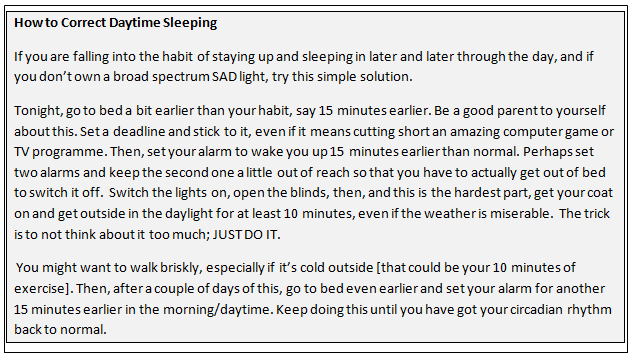 In the winter months, many people risk becoming emotionally low, negative, and stressed. Their appetite for high calorie junk food might increase, their libido often goes out the window, and they might feel incredibly lethargic, finding it difficult to motivate themselves to exercise, leave home, or even get out of bed. Contradictorily, they may tend to stay up late or sleep badly.
In the winter months, many people risk becoming emotionally low, negative, and stressed. Their appetite for high calorie junk food might increase, their libido often goes out the window, and they might feel incredibly lethargic, finding it difficult to motivate themselves to exercise, leave home, or even get out of bed. Contradictorily, they may tend to stay up late or sleep badly.
These are all typical symptoms of depression, but when this cluster of symptoms is triggered in the winter months in susceptible people, it is called Seasonal Affective Disorder, or SAD.
A Survival Mechanism?
It is possible that SAD is an out of date hibernation mechanism; that it is nature’s way of getting us to curl up under skins in our caves and ride out the winter months without expending too much energy. Conserving and storing energy to minimise the need to go outside to fend for the family in the middle of a cold European winter makes survival sense, especially before the invention of cars, trains, cities and supermarkets.
The trouble is that this behaviour is not well adapted to our lives today; what with need to get up and out to nine to five jobs and early classes. On top of this, electricity allows us to work inside all day and stay up way past sunset, so our circadian rhythm, or biological clock, gets out of whack, aggravating the problem.
Light Therapy
Research suggests that one of factors involved in SAD is a reduction of the intensity and duration of sunlight we are exposed to. Many people have been successfully treated for SAD with the introduction of special lights that give off an intense broad spectrum of light, much like the natural light coming from the sun. Some light-therapy lights can even mimic sunrise at an early hour, which basically seems to trick our body into thinking that it is summer and creates a much more pleasant and natural start to the day than blaring alarm clocks in the darkness of the winter morning.
However, if you don’t have access to such a light, you can still improve your condition. Hard as it is, make yourself get out in the daylight for at least half an hour a day, even if it’s cold and overcast. The earlier in the day the better. [See the box below.]
Exercise
Secondly, make yourself exercise. Getting your heart rate up and moving your body is not just good for your physical health, it has been found to be one of the key ways to treat depression and manage stress. If you don’t have time, make time; even 10 minutes a day would make a difference and everyone can afford that. You could combine the daylight therapy and exercise by taking a brisk walk in the early morning light, or walking all or part of the way to work, in lieu of the bus. If neither of these options suits you, or if it really is blowing a gale outside, you could do an indoor exercise routine, such as one of the thousands on youtube. Type in ‘10 minute workout’ into the YouTube search box and you will find a plethora to choose from. Make sure you choose a routine that is suitable for your level of fitness and flexibility [ask your doctor if you are unsure], and vary your choice so that different muscle groups are able to work and rest each day. Force yourself to participate at first, no excuses, until daily exercise eventually becomes part of your routine, as necessary and easy as brushing your teeth.
Eat Well
Watch your diet. Try not to get obsessive about this, but if you find yourself massively overeating the wrong things, stop buying high calorie junk food. Pig out on vegetables. Salads are great, but hot cooked vegetables, especially those that are steamed or in homemade soup, are fine. If you want a sugar hit, try fresh fruit. Again, cook it if you must. If you want a savoury taste, eat meat, eggs, fish or vegetables.
Many people believe that eating foods that are high in Vitamin D, such as oily fish and eggs, can help SAD sufferers. This makes logical sense because our bodies need sunlight to manufacture vitamin D, and vitamin D has been found to be important in the functioning and communication of cells throughout the body, including nerve cells. However, several recent studies have failed to show significant differences between SAD patients who were given vitamin D supplements and those who were not, so the jury is still out on this one.
How to Correct Your Out of Whack Sleep Routine
If you are falling into the habit of staying up and sleeping in later and later through the day, and if you don’t own a broad spectrum SAD light, try this simple solution. Tonight, go to bed a bit earlier than your habit, even if it’s 15 minutes earlier. Be a good parent to yourself about this. Set a deadline and stick to it, even if it means cutting short an amazing computer game or TV programme. Then, set your alarm to wake you up 15 minutes earlier than normal. Perhaps set two alarms and keep the second one a little out of reach so that you have to actually get out of bed to switch it off. Then, and this is the hardest part, get your coat on and get outside in the daylight for 10 minutes, even if the weather is frightful. The trick is to not think about it too much; JUST DO IT. You might want to walk briskly, especially if it’s cold outside [that could be your 10 minute exercise]. Then, after a couple of days of this, go to bed even earlier and set your alarm for 10 or 15 minutes earlier in the morning/daytime. Keep doing this until you have got your circadian rhythm back to normal.
So, in summary, if you are suffering from Seasonal Affective Disorder:
• Get more natural light on your face, especially in the early morning.
• If you can afford it, get a SAD light therapy light and set it to wake you up.
• Go to bed earlier and get up earlier.
• Exercise regularly.
• Eat well.

For more information on combating symptoms of depression, you might want to look at my ‘How to Feel Happier’ article on this website, and please don’t be afraid to ask a therapist, or your family, friends or GP for help. I hope you have a lovely winter.
